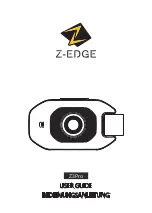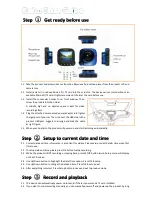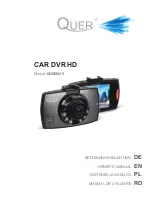
8
—
The thermal imaging camera is a complex electro-optical device
and may malfunction just as any other electronic system. If the
camera fails, the user will no longer receive thermal images. For this
reason, when using this thermal imaging camera in tactical
missions, make sure to follow the procedures established for
conducting operations that do not involve the use of a thermal
imaging camera.
—
Do not use the thermal imaging camera as the sole navigation
source. Failure to follow the established procedures in hazardous
environments can result in disorientation, injuries or death if a
device malfunction occurs.
—
Opening this unit may cause possible injuries by electrical shock.
Only qualified service personnel may service the unit.
—
If you expose the thermal imaging camera repeatedly or for long
periods of time to high ambient temperatures without allowing the
thermal imaging camera time to cool down, the image quality may
be impaired, the thermal image may be lost or the internal
components may be damaged.
Allow for a sufficient cool down time between missions in
environments with high temperatures.
—
The service life of the thermal imaging camera depends on the
ambient conditions in which it is used. The service life will be
reduced with heavy use or under extreme ambient conditions.
—
The batteries supplied with the thermal imaging camera were selected
based on certain performance criteria. To ensure reliable operation,
use only batteries or packs shown in the Order List (see page 27).
—
The operating time of every battery will be reduced if used in
environments with high or very low temperatures.
—
Before using the thermal imaging camera, always conduct a visual
inspection of the camera and accessories in order to ensure that
it is not damaged in any way and that no parts are missing.
—
The thermal imaging camera is not intrinsically safe.
Do not use the thermal imaging camera in environments in which
atmospheric charges or sparks can cause an explosion.
—
Only replace the battery in a safe, non-hazardous environment
only, because in some hazardous environments sparks or
atmospheric charges may cause an explosion.
What is What
see page 3, figure A:
1
Front nose protection
2
Lens
3
Visor
4
Side straps
5
Rechargeable battery
6
Tripod and handle connection
7
Video/transmitter connector
8
Battery latch
9
Screen
10
Thermal scan buttons (optional)
11
LED 1
12
Transmitter/image capture button (depending on handle type)
13
LED 2
14
Handle
15
Thumb wheel
16
Mode button
17
ON/OFF button with green LED
Summary of Contents for UCF 1600
Page 2: ......
Page 295: ...295...
Page 346: ...346 360 361 Dr ger Safety 1334 2000 E Dr ger Safety IP67...
Page 348: ...348 flashover UCF1600 3200 Dr ger Li Ion D Dr ger Safety...
Page 349: ...349 Dr ger Safety 0 o...
Page 351: ...351 18 19 20 21 ThermalScan CP 01 CP 02 CP 06 356 23 Li Ion SHUTDOWN 10 80 60 40 20 Shutdown...
Page 352: ...352 24 oC oF 20 10 ThermalScan 21 oC oF Dr ger Safety Lithium Ion 4 22 oC 72 oF...
Page 354: ...354 LED D...
Page 358: ...358 FM Video Dr ger Safety 1 LED 1 2 2 LED 2 LED SD USB PC USB 15...
Page 360: ...360 n LED...
Page 361: ...361 360 360 3 6 Dr ger Dr ger Safety...
Page 362: ...362 ON OFF Dr ger Safety ON OFF LED 5 LCD Dr ger Safety Dr ger Safety...
Page 363: ...363 Dr ger Safety LED 0 oC 35 oC 32 oF 95 oF LED...
Page 364: ...364 Dr ger Safety Dr ger Safety 60 cm Dr ger Safety Dr ger Safety Dr ger Safety PC...
Page 365: ...365 LED 1 PC USB USB LED 2 Dr ger Safety LED 1 LED 2 USB...
Page 366: ...366 LED In Line LED LED z B WD 40...
Page 371: ...371...
Page 372: ...372...
Page 373: ...373...
Page 375: ......









































